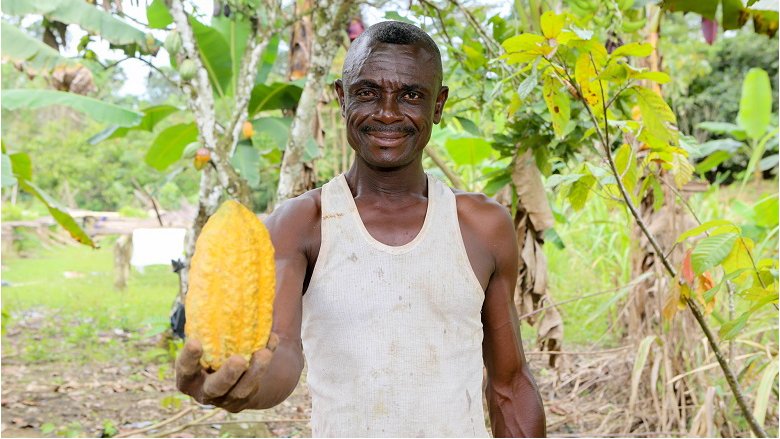Three years ago, Adwoa Akyaa’s 15-acre cocoa farm was “nothing to write home about,” she says, and this may once have been true. While Ghana is the second-largest global producer of cocoa, average yields from individual farms remain low. These days, however, Akyaa is among 140,000 farmers in Ghana adopting innovative practices, revitalizing their lands and enhancing their cocoa stocks. They are not only producing more cocoa but also reducing greenhouse gas emissions —and generating carbon credits that are paying dividends.
“It has a been a great journey,” says Akyaa, whose farm is in the southern Ashanti region. She credits Ghana’s program for reducing emissions from deforestation and forest degradation and enhancing carbon stocks (REDD+) for helping to turn her farm around. “We were taught how to grow shade trees on our cocoa farms. And due to this, my cocoa trees are very healthy and strong. If you are a farmer, you need to grow shade trees because they nourish the soil, and in turn, you will get a lot of yield.”
Going Big on Climate-Smart Cocoa
The government’s program, known as GCFRP, empowers farmers to improve their cocoa plantations. They learn how to plant shade trees to reduce the heat on the ground and increase production; they also learn how to prune effectively and apply other sustainable farming techniques. The program stretches across 6 million hectares of the West Africa Guinean Forest. It’s an area where agricultural expansion, illegal logging, and other pressures have contributed to tree and biodiversity loss and, ultimately, to global warming.
The average productivity of cocoa farms in the program area has increased from 400 kg per hectare to 600 kg per hectare since 2019. Higher yields of sustainably produced cocoa beans is not only good news for farmers but also for private sector buyers with zero-deforestation supply chain commitments. The growing demand for sustainably sourced cocoa can expand certification processes that can fetch even better prices and more secure livelihoods for climate-smart cocoa farmers.
The productivity of cocoa farms in the program area has increased from 400 kg per hectare to 600 kg per hectare since 2019.
“The climate smart techniques that make cocoa farming more productive and profitable also make our forest landscapes healthier and better able to capture and sequester greenhouse gas emissions that cause climate change,” says Mr. John Allotey, Chief Executive of the Forestry Commission. “Ghana’s success is showing the world how to decarbonize a global commodity supply chain, literally, from the ground up for multiple benefits.”
Nana Baffour Adjei, the Krontihene (chief) of Assin-Jakai and Assin-Praso, observes that "the real benefit of this program is the improvement in cocoa yields, the preservation of our forest, alternative livelihood projects that have helped to diversify income streams, and the renewed interest in sustainable cocoa farming."
Training, Technology, and Integrity to Measure Success
Measuring success by the amount of cocoa beans produced is easy; measuring carbon emissions reduced through sustainable farming is a far more complicated process. Ghana’s government has used technical assistance and training provided by the World Bank’s Forest Carbon Partnership Facility (FCPF) to strengthen its systems for measuring, reporting, and verifying emission reductions. Once verified, emission reductions can be converted into carbon credits that Ghana can use to meet its nationally determined contributions (NDC) under the Paris Agreement.
Measuring success by the amount of cocoa beans produced is easy; measuring carbon emissions reduced through sustainable farming is a far more complicated process.
With trained personnel and trusted methodologies, Ghana is using a combination of remote sensing technology and ground-based sampling to monitor forest carbon dynamics. This includes gathering state-of-the-art satellite imagery and using tools such as Collect Earth, combined with the expert opinion of highly qualified and trained interpreters, to identify changes in forest cover. Moreover, 168 plots of the national forest inventory inside the Program area monitor and estimate emission factors.
“Digital technologies are helping us improve accuracy and efficiency, but we also look to local communities to support measurement, reporting, and verification of emission reductions and removals. Their intimate knowledge of the local areas helps us define land use dynamics and accurately map the extent of Ghana’s forests and associated land use change,” explains Ms. Roselyn Fosuah Adjei, Director Climate Change of the Forestry Commission.
Ghana is also working with the World Bank’s PROGREEN to bring 210,000 hectares of cocoa forest landscape within Community Resource Management Areas (CREMAs), an approach which empowers local communities to drive change and shape their nature-resilient futures. This support is specifically aimed at benefitting farmers – 2,855 of whom to date have adopted more sustainable farming practices – and forms part of the World Bank’s sustainable landscape management approach that connects nature-based investments from land to sea.

